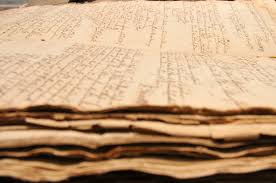Documents and their evolution


A document is a written, drawn, presented or recorded representation of thoughts. Originating from the Latin Documentum meaning lesson – the verb doceō means to teach, and is pronounced similarly, in the past it was usually used as a term for a written proof used as evidence.
Traditionally, the medium of a document was paper and the information was applied to it as ink, either by hand to make a hand-written document or by a mechanical process such as a printing press or, more recently, a laser printer.
Through time, documents have also been written with ink on papyrus, starting in ancient Egypt or parchment; scratched as runes or carved on stone using a sharp apparatus, such as the Tablets of Stone described in the bible; stamped or cut into clay and then baked to make clay tablets in the Sumerian and other Mesopotamian civilisations.
The paper, papyrus or parchment might be rolled up as a scroll or cut into sheets and bound into a book. Today short documents might also consist of sheets of paper stapled together.
In the computer age, a document is usually used to describe a primarily textual file, along with its structure and design, such as fonts, colours and additional images.
The modern term ‘document’ can no longer be defined by its transmission medium (such as paper), following the existence of electronic documents. ‘Documentation’ has more meanings than a written or drawn presentation of thoughts.
Modern electronic means that storing and displaying of documents is more efficient. Typically using the Portable Document Format PDF storage methods include:
- Desktop computer
- Laptop
- Tablet PC
- PDA
- Smart phones
- Dedicated e-book device
- Digital audio players
- The Cloud
PDM can vastly improve your systems by offering an instantly accessible and searchable storage facility for documents in a secure environment. This can be any and or all the methods above.
To discuss moving forward call 01274 883459
Email andy@pro-doc.co.uk


